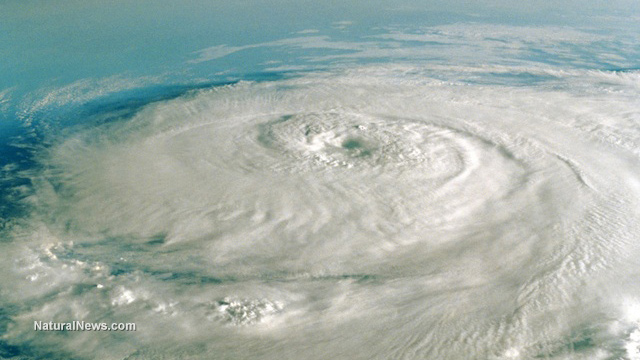100 years of patents reveal secret history of U.S. weather control programs
Thursday, July 30, 2015 by: J. D. Heyes
Tags: geoengineering, patents, weather control
Tags: geoengineering, patents, weather control
(NaturalNews) Have the U.S. government and American researchers been toying with the notion of controlling, changing or otherwise adapting the weather? According to this comprehensive and exhaustive list of patents, the answer is yes.
In fact, researchers have spent the past century working to develop climate and weather control technologies. But a 1999 study by the U.S. Air Force nailed it: Within three decades, the report's authors concluded, the United States military should have perfected methods to control weather.
As reported at the time by WorldNetDaily, the Air Force study titled, "Weather as A Force Multiplier: Owning the Weather In 2025," which was commissioned by then-Air Force Chief of Staff Michael Ryan and first presented in 1996, authors predicted that the technology was within reach.
As noted by WND:
Military planners have often bemoaned the fact that during critical operations weather has been a mitigating factor. Though the U.S. military is generally considered superior to the forces of other nations and can wage war in most kinds of weather, Air Force operations traditionally have suffered the most from inclement weather like rain, fog, and other low-visibility conditions.
Click here to search GoodGopher.com for more information about geoengineering.
Weather control as a weapon
The Air Force is the branch of service tasked with most of the military's satellite and space surveillance; weather conditions can degrade the ability of sensitive surveillance equipment like infrared technology and imagery programs. As such, the Air Force has long sought to defeat natural phenomena because planners believe that without weather-modification capability, critical combat missions in the future would be hampered, to the detriment of U.S. forces.
"Achieving such a highly accurate and reasonably precise weather-modification capability in the next 30 years will require overcoming some challenging but not insurmountable technological and legal hurdles," the report said.
The authors added that altering weather patterns would eventually become an "integral part of U.S. national security policy with both domestic and international applications."
"Society will have to provide the resources and legal basis for a mature capability to develop," they wrote, signaling that the Air Force believes public reluctance and likely legal battles would be hurdles to the development and deployment of a global weather-modification system.
Today, one of the most widely pursued weather modification techniques is called cloud seeding, using in an attempt to cause rain or snow, generally to boost an area's moisture content.
"Weather modification, commonly known as cloud seeding, is the application of scientific technology that can enhance a cloud's ability to produce precipitation," says the web site Weather Modification, Inc., which says the company is able to provide aerial or ground-based cloud seeding.
The company's current projects listing includes federal and state governments, as well as academic institutes and private corporations (interestingly, the company's client list doesnot include the state of California, which is currently experiencing a historic drought).
Then there is HAARP, one of the better-known weather modification projects. Officially called the High Frequency Active Auroral Research Program, its aim is not simply weather modification but also electromagnetic warfare, according to Canada-based Center for Research on Globalization.
"It isn't just conspiracy theorists who are concerned about HAARP. The European Union called the project a global concern and passed a resolution calling for more information on its health and environmental risks. Despite those concerns, officials at HAARP insist the project is nothing more sinister than a radio science research facility," said a Canadian Broadcasting Corporation documentary, cited by Global Research.
HAARP is a U.S. military program; researchers at the Global Research center believe the technology is part of the Defense Department's "Joint Vision 2020," which seeks to achieve "full spectrum dominance" of battle spaces.
A history of covert military weather modification programs
Weather modification for military defense is not a new idea; in fact, the U.S. military attempted to create weather obstructions during the Vietnam War by dropping silver iodide particles in the clouds during the infamous Operation Popeye. Altheadlines.com describes the operation:
Between 1967 and 1972, the US air force carried out "Operation Popeye", the first use of weather as an instrument of war. Almost 3,000 flights were sent into the skies above the Ho Chi Minh Trail, where planes seeded clouds with silver iodide particles, causing storms and extendingthe monsoon season. "Popeye" turned the strategic pass into a bog -- and appalled the international community. In 1977, the Enmod (Environmental Modification Convention) treaty outlawed weather warfare.
Click here to find articles on GoodGopher.com about Operation Popeye.
HAARP as 'full dominance' weapon
According to a 2000 report by the American Forces Press Service:
Full-spectrum dominance means the ability of U.S. forces, operating alone or with allies, to defeat any adversary and control any situation across the range of military operations.
While full-spectrum dominance is the goal, the way to get there is to "invest in and develop new military capabilities." The four capabilities at the heart of full-spectrum dominance are dominant maneuver, precision engagement, focused logistics and full-dimensional protection.
Read the full Center for Research on Globalization's HAARP report here.
Sources:
http://www.geoengineeringwatch.org
http://mobile.ryan.test.wnd.com
http://www.weathermodification.com
http://www.defense.gov
http://www.globalresearch.ca
http://www.altheadlines.com


